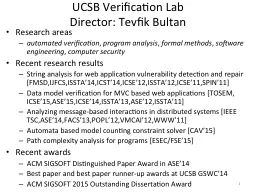

Director Tevfik Bultan Research areas automated verification program analysis formal methods software engineering computer security Recent research results String analysis for web application vulnerability ID: 218424
Download Presentation The PPT/PDF document "UCSB Verification Lab" is the property of its rightful owner. Permission is granted to download and print the materials on this web site for personal, non-commercial use only, and to display it on your personal computer provided you do not modify the materials and that you retain all copyright notices contained in the materials. By downloading content from our website, you accept the terms of this agreement.
Slide1
UCSB Verification LabDirector: Tevfik Bultan
Research areas automated verification, program analysis, formal methods, software engineering, computer securityRecent research resultsString analysis for web application vulnerability detection and repair [FMSD,IJFCS,ISSTA’14,ICST’14,ICSE’12,ISSTA’12,ICSE’11,SPIN’11]Data model verification for MVC based web applications [TOSEM, ICSE’15,ASE’15,ICSE’14,ISSTA’13,ASE’12,ISSTA’11] Analyzing message-based interactions in distributed systems [IEEE TSC,ASE’14,FACS’13,POPL’12,VMCAI’12,WWW’11]Automata based model counting constraint solver [CAV’15]Path complexity analysis for programs [ESEC/FSE’15]Recent awardsACM SIGSOFT Distinguished Paper Award in ASE’14Best paper and best paper runner-up awards at UCSB GSWC’14ACM SIGSOFT 2015 Outstanding Dissertation Award
1Slide2
Web App Vulnerability Detection & Repair
Web App
Sanitizer
f
unctions
V
ulnerability
signatures
Static and dynamic program analysis to extract
input validation and sanitization operations
GOAL:
To automatically detect and repair vulnerabilities that are caused by input validation and sanitization errors (such as XSS and SQL Injection)
A
utomata based string analysis using symbolic
fixpoint
computations
Differential or policy directed (using attack patterns) bug detection
and repair
Bug reports (attack strings) and code patchesSlide3
Web App Data Model Verification & Repair
(1) Model Extraction(4) Verification
Bug
reports
(property violating instances)
Rails
code
FOL or Boolean
formulas
(3) Logic Translation
Formal
data
m
odel
(5) Data
Model Repair
GOAL:
To automatically detect and repair data model errors in web apps written using MVC based
f
rameworks (such as Ruby on Rails)
(2) Property
Inference
Static analysis
+
i
nstrumented
execution
Encoding in
First Order
Logic
(unbounded)
or
Boolean logic (bounded)
Verification
via
automated theorem
provers
or
SAT solvers
Search for property
patterns
in
d
ata model schema
Formal
data model +properties
User specified properties
Code
patches
Automated
r
epair based
on propertypattersSlide4
Analyzing Message-based Interactions
GOAL: Automated analysis of distributed systems which use message-based communicationAPPLICATIONS: Deadlock detection in web services, Erlang programs, Singularity OS processes IO_RUNNING$0
IO_RUNNING
ReadyState
ReadyState$1
ReadyState$0
C
S:
Send
S
C:
AckStartSend
S
C:
SendComplete
C
S:
GetTpmStatus
S
C:
TpmStatus
S
C:
TpmStatus
C
S:
GetTpmStatus
Input communication protocol
Message-
based communication:
a
synchronous
(
using FIFO message buffers
)
synchronous
(rendezvous communication)
Realizability check:Is the protocol implementable in a distributed manner without deadlocks?
Synchronizability check:Does the protocol behavior change with synchronous vs. asynchronous communication
Results:
R
ealizability and synchronizability checks are decidableIdentified a subclass of asynchronously communicating systems which can be verified automatically
Identified a flaw in Singularity OS protocol verification frameworkSlide5
Constraint AST
Constraint Automata(1)
syntactic
simplification
& normalization
(
2)
Incremental
automata
construction
(3)
Path counting function generation based on algebraic graph theory
3.1. Generating function construction
3.2. Recurrence relation
construction
3.3. Closed form solution
generation
Input bound
Number of solutions
for the constraint
within the given
input bound
Input Constraint
(SMT-LIB format)
Model counting function
GOAL:
Given a constraint, generate a model counting function that returns the number of solutions within a given bound
APPLICATIONS:
Quantitative information flow, probabilistic verification
APPROACH:
Construct an automaton that accepts all the solutions to the given constraint, which reduces the model counting to path counting
Model Counting Constraint SolverSlide6
Computing Path Complexity of Programs
(1) Input Java code (2) Control Flow Graphpath(n) = 6.86 (1.17) +
0.22 (1.09)
+
0.13 (0.84)
+
2
n
n
n
(3) Path complexity function
path(n) =
Θ
(
1.17
)
n
GOAL:
Given a program, generate a path complexity function that returns the number of paths in the program within a given depth
APPLICATIONS: Determining
difficulty of path coverage, guidance for verification and testing heuristics
APPROACH:
Path counting function generation
on
the control flow graph
(4) Asymptotic path complexity